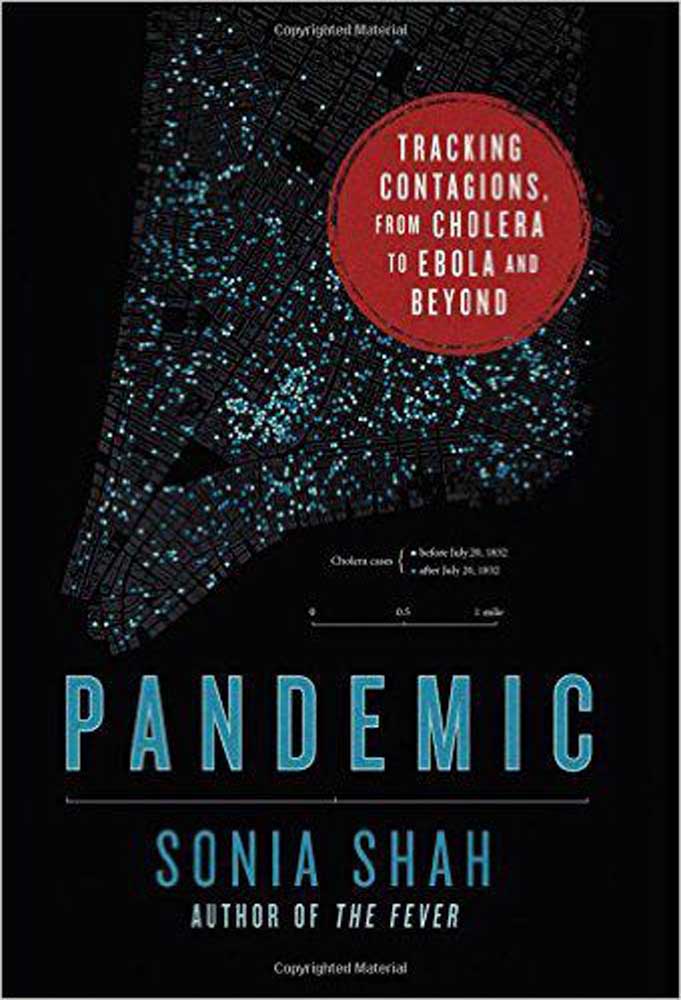‘Pandemic’ on how to host the perfect pathogen party
Published 12:00 am Sunday, February 28, 2016

- ‘Pandemic’ on how to host the perfect pathogen party
Sometimes, the best approach to a book about deadly pathogens is to read it in a slightly dissociated state — it allows you to marvel at the cunning adaptability of microbial life, rather than contemplate the far creepier possibility of your own doom.
In her introduction to “Pandemic: Tracking Contagions, From Cholera to Ebola and Beyond,” Sonia Shah, a science writer whose previous books include “The Fever” and “The Body Hunters,” does not seek shelter in euphemisms or shy away from scary numbers. Instead, she cites a study in which 90 percent of epidemiologists say they believe a global pandemic will sicken 1 billion and kill up to 165 million within the next two generations.
Looking closely at the source of this statistic — a paper by epidemiologist Larry Brilliant and three colleagues — I’m not convinced that things are quite so dire. (The number of epidemiologists he surveyed is actually quite small.) But there’s no doubt that new forms of pestilence are appearing in the world with an almost metronomic regularity and that old ones are reappearing in new places, the Zika virus being only the most recent example.
And pandemics are never pretty. Here is Shah’s description of what happened to Parisians when they were infected with cholera in 1832:
“Fluid blood turned tarry, clotting in the blood stream. Muscles, deprived of oxygen, shuddered so violently that they sometimes tore. As the organs collapsed in turn, victims fell into acute shock, all the while fully conscious and expelling massive amounts of liquid stool.”
The good news is that cholera made quick work of its victims. It was said that someone with cholera could feel perfectly fine at dinner and expire by dessert.
Yet once you get past the unfriendly statistics of the book’s introduction, and once you get past the chilling biology lesson of Chapter 1 — which explains how these sneaky organisms jump from one species to the next — “Pandemic” is far less terrifying, perhaps because errant microbes are only one component of what makes a pandemic a pandemic. They’re the “known unknowns,” as Donald Rumsfeld might put it.
The other components are known knowns, which by definition are at least familiar: filth, political corruption, increasing population density and mobility.
Shah uses cholera, one of the most obdurate of pandemics, as a paradigm to explain how new deadly pathogens both emerge and circulate. If you already know something about cholera — if you’ve read Steven Johnson’s excellent “The Ghost Map,” say — you may find yourself disappointed; she covers, inevitably, some of the same ground.
But this structuring conceit is also useful for simplifying an unwieldy topic. A discussion about the East India Co.’s expansion into the wetlands in the Bay of Bengal, which exposed many Indian workers to the tiny crustaceans that carry vibrio cholera, becomes the perfect segue to discuss how modern deforestation in Guinea encouraged more interaction between people and fruit bats, which are thought to carry Ebola.
“As wetlands were paved over and forests were felled, different species came into novel, prolonged contact with each other,” she explains. From a pandemic’s point of view, the more mingling among species the better.
For those who don’t know much about the history of cholera, Shah’s dense, compact book is a decent primer, explaining how new forms of transportation encouraged the spread of this waterborne disease, as did rising urban density, as did political corruption. (It was Aaron Burr who thwarted an attempt to bring clean water from the Bronx River into New York City — as if this man needed any more negative publicity.)
Perhaps my favorite chapter, though, is about waste — or, as Shah puts it, “the rising tide of feculence.” Nothing seems to awaken the muse in Shah like excreta, the ideal delivery system for all kinds of diseases. In each gram is up to 1 billion viral particles; yet somehow, Christianity shunned water-based rituals for centuries. Martin Luther went so far as to eat a spoonful of his own feces every day.
In 19th-century New York City, sanitation was extravagantly grim. “By 1820,” Shah writes, “privies and cesspools covered one-twelfth of the city.” Human and horse waste covered the streets and seeped into the groundwater; it was sometimes sold as fertilizer for “sewage farming” in Brooklyn and Queens.
The same conditions that drove cholera — overcrowding, corruption, poor hygiene, expanded transportation — are what drive pandemics today.
In the age of cholera, shipping trade helped spread disease. Today, it’s air travel — if you want to understand the helter-skelter distribution of flu outbreaks, simply consult a map of airline routes.
In the age of cholera, politicians obfuscated and denied their way through the epidemic; today, the World Health Organization, the globe’s dedicated first responder, is so deprived of public funding that its private donors disproportionately control the agenda — which often has nothing to do with controlling pandemics.
Today overcrowding is not just in cities, but on farms, which have gotten denser and dirtier. In the United States, they’ve become breeding grounds for E. coli; in China, poultry farms have grown so large they’ve created many opportunities for interactions with wild waterfowl, which can lead to new strains of the flu.
Complicating matters is climate change. Warmer waters have washed cholera-rich surf into Alaska and Chile and Iceland. A cold winter altered the migration patterns of wild swans in 2006, which meant they ferried a new flu into more than 20 countries in Europe; an unseasonably warm New York winter in 1999 contributed to the West Nile outbreak.
To me, however, the most provocative — and sci-fi — part of Shah’s book is not about the ways humans have altered the evolution of pandemics. It’s about what the ways pandemics have altered the evolution of humans. Pathogens, Shah explains, have always been the body’s antagonists. Every time we adapt to combat one, it counteradapts to harm us back.
It is for this reason, she writes, that some evolutionary biologists believe we’ve evolved to have sex, rather than to clone ourselves — by diversifying the gene pool, we’re confounding pathogens, making it harder for them to keep up with our ever-shuffling genetic variations.
Shah ends her book on both a hopeful and cautious note. The cautious note is intriguing: Shah suggests that the real danger with pandemics is that humans often start to treat them as mere inconveniences, rather than crises (which is how many Africans treat malaria and many Americans treat the flu).
As for the optimistic note: I wasn’t buying it. She makes a case for building a worldwide, highly attuned surveillance system. “A network of clinics,” she writes, “staffed with health care workers trained to recognize and report new pathogens, could do the trick.”
No doubt it would. But, politically speaking, achieving this goal is about as likely as eradicating pathogens themselves. Now that is scary.








